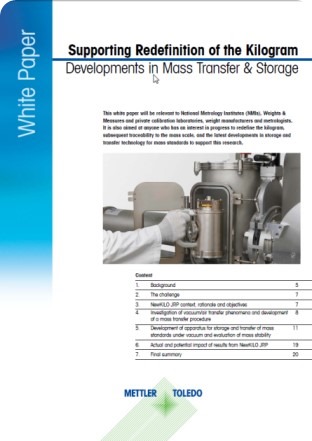A new white paper, "Supporting Redefinition of the Kilogram", explains the latest developments in transfer and storage of mass standards under vacuum or in a controlled environment. It also reports the findings and recommendations from the NewKILO Joint Research Project (JRP), in which research was undertaken to prepare for implementation of the new definition of the kilogram in 2018.
The NewKILO JRP, a three-year project of the European Metrology Research Programme (EMRP) involving 13 National Metrology Institutes (NMIs) and co-funded by the European Union (EU), was completed in May 2015. The future definition will require the unit of mass to be realized in a vacuum, instead being maintained and used in air, which presents some challenges to establishing traceability to the mass scale.

This white paper describes the research undertaken in relation to storage, transport, and transfer of mass standards between air and vacuum, which is critical in establishing traceability of new methods under vacuum to existing methods in air, and dissemination of the kilogram after the redefinition in 2018.
In parallel, METTLER TOLEDO has developed new apparatus to enable the transfer of artefacts to the M_one mass comparator under a controlled atmosphere (such as vacuum or inert gas), preventing air contamination. This apparatus consists of an Artefact Transfer Device (ATD) and an Artefact Storage and Transport Vessel (ASTV).
The ASTV is made of high-grade stainless steel and can accommodate a range of 1 kg weight types, including Pt-Ir cylinders, silicon spheres, and stainless steel OIML shaped or cylinder weights, without the need for adapter plates. Automated Gravimetric Centering (AGC) ensures correct positioning, minimizing eccentricity and ensuring the highest possible repeatability.
The M_one mass comparator, with a resolution of 100 nanograms and a typical repeatability of 300 nanograms, enables NMIs to achieve the most accurate results for weights calibration, with the smallest possible measurement uncertainties, in the shortest time. External influences are reduced to a minimum using vacuum technology, which enables measurements under a controlled environment from ambient pressure down to a vacuum of 10-6 mbar (10-4 Pa).
As the future definition of the kilogram will be measured in a vacuum, the M_one mass comparator, along with the Artefact Transfer Device (ATD) and Artefact Storage and Transfer Vessel (ASTV), enable transfer of an artefact from one piece of apparatus to another whilst keeping it constantly under vacuum. These devices will play a vital role in current and future research to support the redefinition of the kilogram project, including dissemination of the new kilogram following the redefinition in 2018.
METTLER TOLEDO is proud that M_one technology is leading the way to a higher level of weighing accuracy in current research to redefine the kilogram. To learn more about the M_one’s role in the effort, or to discover how an NMI, governmental, or research organization can obtain this specialized technology, download the free white paper.
This white paper will be relevant to National Metrology Institutes (NMIs), Weights & Measures and private calibration laboratories, weight manufacturers, and metrologists. It is also aimed at those with an interest in progress to redefine the kilogram, subsequent traceability to the mass scale, and the latest developments in storage and transfer technology for mass standards to support this research.